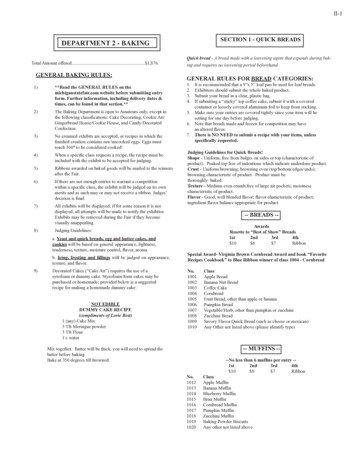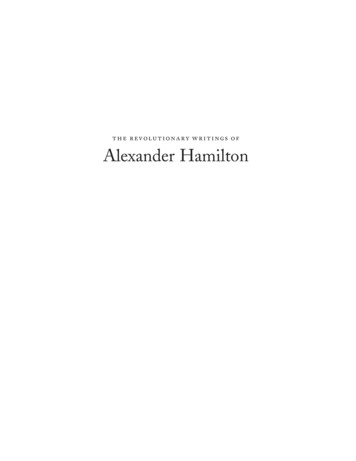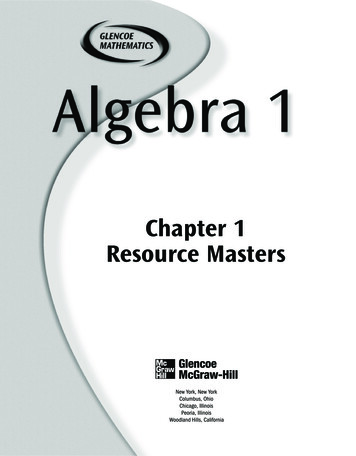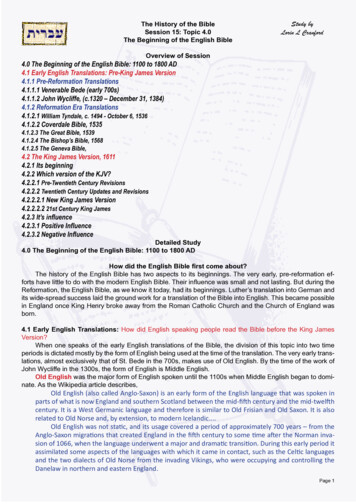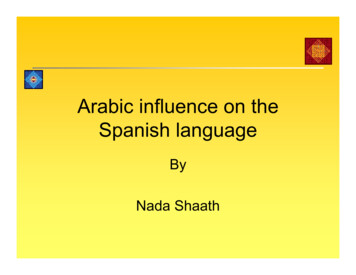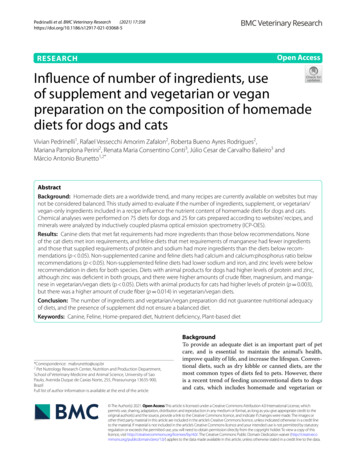
Transcription
(2021) 17:358Pedrinelli et al. BMC Veterinary Open AccessRESEARCHInfluence of number of ingredients, useof supplement and vegetarian or veganpreparation on the composition of homemadediets for dogs and catsVivian Pedrinelli1, Rafael Vessecchi Amorim Zafalon2, Roberta Bueno Ayres Rodrigues2,Mariana Pamplona Perini2, Renata Maria Consentino Conti3, Júlio Cesar de Carvalho Balieiro3 andMárcio Antonio Brunetto1,2*AbstractBackground: Homemade diets are a worldwide trend, and many recipes are currently available on websites but maynot be considered balanced. This study aimed to evaluate if the number of ingredients, supplement, or vegetarian/vegan-only ingredients included in a recipe influence the nutrient content of homemade diets for dogs and cats.Chemical analyses were performed on 75 diets for dogs and 25 for cats prepared according to websites’ recipes, andminerals were analyzed by inductively coupled plasma optical emission spectrometry (ICP-OES).Results: Canine diets that met fat requirements had more ingredients than those below recommendations. Noneof the cat diets met iron requirements, and feline diets that met requirements of manganese had fewer ingredientsand those that supplied requirements of protein and sodium had more ingredients than the diets below recommendations (p 0.05). Non-supplemented canine and feline diets had calcium and calcium:phosphorus ratio belowrecommendations (p 0.05). Non-supplemented feline diets had lower sodium and iron, and zinc levels were belowrecommendation in diets for both species. Diets with animal products for dogs had higher levels of protein and zinc,although zinc was deficient in both groups, and there were higher amounts of crude fiber, magnesium, and manganese in vegetarian/vegan diets (p 0.05). Diets with animal products for cats had higher levels of protein (p 0.003),but there was a higher amount of crude fiber (p 0.014) in vegetarian/vegan diets.Conclusion: The number of ingredients and vegetarian/vegan preparation did not guarantee nutritional adequacyof diets, and the presence of supplement did not ensure a balanced diet.Keywords: Canine, Feline, Home-prepared diet, Nutrient deficiency, Plant-based diet*Correspondence: mabrunetto@usp.br2Pet Nutrology Research Center, Nutrition and Production Department,School of Veterinary Medicine and Animal Science, University of SaoPaulo, Avenida Duque de Caxias Norte, 255, Pirassununga 13635‑900,BrazilFull list of author information is available at the end of the articleBackgroundTo provide an adequate diet is an important part of petcare, and is essential to maintain the animal’s health,improve quality of life, and increase the lifespan. Conventional diets, such as dry kibble or canned diets, are themost common types of diets fed to pets. However, thereis a recent trend of feeding unconventional diets to dogsand cats, which includes homemade and vegetarian or The Author(s) 2021. Open Access This article is licensed under a Creative Commons Attribution 4.0 International License, whichpermits use, sharing, adaptation, distribution and reproduction in any medium or format, as long as you give appropriate credit to theoriginal author(s) and the source, provide a link to the Creative Commons licence, and indicate if changes were made. The images orother third party material in this article are included in the article’s Creative Commons licence, unless indicated otherwise in a credit lineto the material. If material is not included in the article’s Creative Commons licence and your intended use is not permitted by statutoryregulation or exceeds the permitted use, you will need to obtain permission directly from the copyright holder. To view a copy of thislicence, visit http:// creat iveco mmons. org/ licen ses/ by/4. 0/. The Creative Commons Public Domain Dedication waiver (http:// creat iveco mmons. org/ publi cdoma in/ zero/1. 0/) applies to the data made available in this article, unless otherwise stated in a credit line to the data.
Pedrinelli et al. BMC Veterinary Research(2021) 17:358vegan diets. A survey conducted in the United States andAustralia [1] observed that 18% of dogs and cats were fedhome-prepared diets, either as a part of the diet or as themain diet. A questionnaire survey [2] applied to morethan 3000 owners of dogs and cats from 55 countriesobserved that more than 60% of pets were fed homemadefood as a part of the diet, and 12% of dogs and 6% of catswere fed exclusively this type of diet.Feeding unconventional diets, however, may put theanimals at risk. The World Small Animal VeterinaryAssociation has published a set of guidelines regarding nutritional assessment [3], which refer to nutritionalevaluation as the 5th vital sign, along with temperature,pulse, respiration, and pain assessment. These guidelinesalso consider feeding an unconventional diet, such as raw,homemade, or vegetarian, a risk factor for dogs and cats.The vegetarian and vegan population seems to beincreasing worldwide. A survey in Brazil [4] indicatedthat between 8 and 14% of the population evaluated isvegetarian, and a poll conducted in the United States [5]observed that 5% of the population surveyed is vegetarian and 3% is vegan. In the United Kingdom, the veganpopulation was estimated to be only 0.25% in 2014 butincreased to 1.16% of the population in 2019 [6]. Indiais the country with the highest percentage of vegetarianism: 28.4% of males and 29.3% of females do not eatmeat [7]. The main motivations for humans becomingvegetarians or vegans are ethical and health concerns,environmental or sustainability reasons, and religion[8]. The owner’s dietary choice can influence the type offood they choose to feed their dogs or cats. An onlinestudy [9] that included 3673 English-speaking pet ownersobserved that 6.2% were vegetarian and 5.8% were vegan.It was also observed that the majority of pets that werefed plant-based or vegan diets had vegan owners.Regardless of being meat- or plant-based, homemadediets need to supply all nutrient requirements. Oneof the items that is considered essential in homemadediets for pets is the vitamin-mineral supplement, whichguarantees that all nutrients are present in the diet sincecommon ingredients do not provide all the nutrientrequirements. If a diet is formulated without proper supplementation, it can be deficient, especially in mineralsand vitamins [10, 11]. However, even owners who haveprofessionally-prescribed diets that contain supplementsmay omit this ingredient during preparation [12, 13]. Acommon practice among owners who feed homemadediets to their pets is the variety of ingredients in the formula, as they believe the frequent substitution of ingredients or the addition of more ingredients can ensurethe diet meets the nutrient requirements, as opposed to“fixed” formulas [14]. This, however, may or may not bePage 2 of 9true, and depends on what ingredient is substituted oradded.Therefore, this study hypothesizes that vegetarian orvegan diets and diets without supplements will be nutritionally deficient and that the number of ingredientswill not influence the nutritional adequacy of diets. Thisstudy aimed to evaluate the influence of the number ofingredients, the presence of supplement, or vegetarian/vegan recipes on the nutrient content of homemade dietsaccording to FEDIAF [15] and NRC [16].ResultsNone of the diets were considered complete and balanced when compared to NRC [16] and FEDIAF [15],as previously published [10]. The recipes for dogs had amean of 6.6 ingredients (range 4–14) and the recipes forcats used a mean of 9.1 ingredients (range 3–15). Whenmineral and vitamin-mineral supplements are not considered, recipes for dogs had a mean of 5.8 ingredients(range 3–12) and recipes for cats had a mean of 6.8 ingredients (range 3–13).The results regarding the influence of the number ofingredients in diets for dogs are presented in Table 1 andfor cats in Table 2. Canine diets that met fat requirementshad more ingredients than those below recommendations. Feline diets that met requirements of manganesehad fewer ingredients and those that supplied requirements of protein and sodium had more ingredients thandiets below recommendations (p 0.05). None of the catdiets met iron requirements.Of the 75 recipes for dogs, 33.3% (n 25/75) did notindicate mineral or vitamin-mineral supplementation.If we consider the diets that only included salt, this percentage increases to 44.4% (n 33/75). Of the dietssupplemented, 14.0% (n 7/50) only included calciumsources such as calcium carbonate or eggshell powder.The supplements that contained minerals indicated in therecipes for dogs were: salt (n 15/75), veterinarian vitamin-mineral supplements of different brands (n 15/75),eggshell powder (n 9/75), calcium carbonate (n 8/75),dicalcium phosphate (n 3/75), potassium chloride(n 2/75), zinc (n 2/75), calcium citrate (n 1/75), andvitamin-mineral supplement for children (n 1/75).Veterinarian vitamin-mineral supplements were notindicated in any of the recipes for cats. Only one recipecontained a children’s vitamin-mineral supplement, 8(32.0%) did not include any type of mineral supplementation, and 2 (8.0%) only included calcium sources. Thesupplements that contained minerals indicated in therecipes for cats were: salt (n 10/25), calcium carbonate(n 9/25), eggshell powder (n 5/25), and vitamin-mineral supplement for children (n 1/25).
Pedrinelli et al. BMC Veterinary Research(2021) 17:358Page 3 of 9Table 1 Comparison of number of ingredients and nutrients per 1000 kcal in diets for dogsNumber of ingredientsCrude proteinEther extractCalciumPhosphorusNRCFEDIAFMean ingredient number Mean ingredient number pof diets below ( SE)of diets above ( SE)Mean ingredient number Mean ingredient number pof diets below ( SE)of diets above ( SE)3.00 1.735.86 0.280.2515.71 0.645.85 0.310.8475.81 0.335.87 0.510.9195.82 0.315.75 0.690.8845.86 0.325.86 0.910.9615.58 0.386.08 0.410.3715.90 0.310.5765.80 0.360.9074.50 0.614.84 0.616.08 0.310.0426.03 0.310.112Ca:P1 ratio–––Potassium5.65 0.336.21 0.510.3515.29 0.476.08 0.350.1926.18 mZinc3.87 0.705.00 0.715.12 0.455.83 0.49a5.82 0.346.06 0.300.0195.95 0.300.2495.82 0.340.987aa5.84 0.480.97314.50 0.615.74 0.385.70 0.285.54 0.375.50 0.635.72 0.375.87 0.44a5.86 0.326.08 0.315.92 0.410.0420.7578.00 1.410.0696.18 0.430.2575.97 0.430.661aa5.70 0.580.815Legend: NRC Nutrient Requirements of Dogs and Cats [16], FEDIAF Fédération Européenne de l’Industrie des Aliments pour Animaux Familiers [15], SE standard error;1Ca calcium, P phosphorusaAll diets had a deficiency of this nutrientTable 2 Comparison of number of ingredients and nutrients per 1000 kcal in diets for catsNumber of ingredientsCrude proteinEther extractCalciumPhosphorusCa:P1 leniumZincNRCFEDIAFMean ingredient number Mean ingredient number pof diets below ( SE)of diets above ( SE)Mean ingredient number Mean ingredient number pof diets below ( SE)of diets above ( SE)4.33 1.205.00 0.795.57 0.897.14 0.577.75 0.707.28 0.640.0970.0720.15610.00 3.166.67 0.530.226––6.40 0.578.40 1.300.140–6.00 2.453.33 1.054.00 2.006.83 0.537.27 0.576.92 0.540.7570.0250.2906.32 0.5410.33 1.850.0216.88 0.636.62 0.910.8207.81 0.706.69 0.655.00 0.757.00 0.880.0170.8204.50 0.875.00 0.796.82 0.637.53 0.637.65 0.676.75 0.920.0220.0280.9486.32 0.588.33 1.180.1136.96 0.543.00 1.730.1625.70 0.765.50 1.664.00 0.826.00 1.73a7.63 0.636.95 0.586.95 0.588.00 0.896.91 0.557.68 0.646.87 0.55a4.17 0.836.00 1.226.00 1.220.1660.4700.0070.655a0.0100.5100.510Legend: NRC Nutrient Requirements of Dogs and Cats [16], FEDIAF Fédération Européenne de l’Industrie des Aliments pour Animaux Familiers [15], SE standard error;1Ca calcium, P phosphorusaAll diets had a deficiency of this nutrientNon-supplemented canine and feline diets had calcium and calcium:phosphorus ratio (Ca:P) (p 0.05)below recommendations. Non-supplemented felinediets had lower sodium and iron, and zinc levels werebelow recommendations in both groups. The resultsregarding the influence of mineral supplementation indiets for dogs are presented in Table 3 and for cats inTable 4.Twelve percent (n 9/75) of recipes for dogs were vegetarian and 6.6% (n 5/75) were vegan, as they did not
Pedrinelli et al. BMC Veterinary Research(2021) 17:358Page 4 of 9Table 3 Comparison of nutrient concentration per 1000 kcal in diets for dogs with or without supplementationNRC(/1000 kcal)FEDIAF(/1000 kcal)Crude protein (g)25.0052.10Ether extract (g)13.8013.75Crude fiber (g)––Ash (g)––Calcium (g)1.001.45Phosphorus (g)0.751.16Ca:P1 ratio–1.00Potassium (g)1.001.45Magnesium (g)0.150.20Sodium (g)0.200.29Copper (mg)1.502.08Iron (mg)7.5010.40Manganese (mg)1.201.67Selenium (μg)87.5087.00Zinc (mg)15.0020.80Mineral supplementationDiets without supplement( SD)93.05 34.6426.57 16.094.51 4.193.33 1.130.31 0.31Diets with supplement( SD)79.57 26.1830.46 16.034.19 3.255.80 3.921.77 1.52p0.06250.23120.6322 0.0001 0.00011.16 0.771.09 0.610.17370.77 0.330.85 0.460.29230.26 0.220.25 0.110.35 0.297.30 6.239.59 5.021.78 1.460.19 0.110.51 0.4911.61 12.3715.34 12.25 0.00010.08440.43900.10990.12283.23 2.693.96 4.090.887311.13 6.9314.98 10.930.25921.53 7.02a0.00 0.00a0.5085Legend: NRC recommended intake according to Nutrient Requirements of Dogs and Cats [16], FEDIAF recommended intake according to Fédération Européenne del’Industrie des Aliments pour Animaux Familiers [15], SD standard deviation; 1Ca calcium, P phosphorusaAll diets had a deficiency of this nutrientTable 4 Comparison of nutrient concentration per 1000 kcal in diets for cats with or without supplementationNRC(/1000 kcal)FEDIAF(/1000 kcal)Mineral supplementationDiets without supplement( SD)Diets with supplement( SD)pCrude protein (g)50.0083.3022.5022.5097.66 57.37142.52 41.410.0605Ether extract (g)Crude fiber (g)––––3.36 3.070.4203Ash (g)5.81 4.51Calcium (g)0.721.970.0011Phosphorus (g)0.641.672.26 1.22Ca:P1 ratio–1.001.302.002.26 2.190.0002Potassium (g)0.50 0.38Magnesium (g)0.100.130.170.250.23 0.070.2521Sodium (g)0.27 0.11Copper (mg)1.201.670.0613Iron (mg)20.0026.7015.53 12.88Manganese (mg)1.201.67Selenium (μg)75.00100.00Zinc (mg)18.5025.0034.64 23.674.56 2.030.70 0.701.29 0.391.00 0.520.46 0.367.23 8.2110.19 3.473.63 4.9820.70 62.10a10.27 5.5233.56 15.030.90506.20 1.330.01141.33 0.510.68271.07 0.360.72070.78 0.410.045815.51 5.550.00950.00 0.00a0.40001.65 3.1419.51 8.190.30420.0037Legend: NRC recommended intake according to Nutrient Requirements of Dogs and Cats [16], FEDIAF recommended intake according to Fédération Européenne del’Industrie des Aliments pour Animaux Familiers [15], SD standard deviation; 1Ca calcium, P phosphorusaAll diets had a deficiency of this nutrientcontain ingredients from animal sources. As for the recipes for cats, 4.0% (n 1/25) were vegetarian and 8.0%(n 2/25) were vegan.Protein and zinc were increased in non-vegetariandiets for dogs, although zinc was deficient in both groups.There were higher amounts of crude fiber, magnesium,
Pedrinelli et al. BMC Veterinary Research(2021) 17:358and manganese in vegetarian and vegan diets (p 0.05).Protein was increased in non-vegetarian diets for cats(p 0.003), but there was a higher amount of crude fiber(p 0.014) in vegetarian and vegan diets. The resultsregarding the influence of preparations with or withoutanimal products in diets for dogs are presented in Table 5and for cats in Table 6.DiscussionThis study evaluated if three factors can influence thenutritional composition of diets: number of ingredients,presence of mineral or vitamin-mineral supplements,and the fact that the recipe is vegetarian or vegan.The number of ingredients influenced the concentration of macro and micronutrients, especially in recipesfor cats. For dogs, differences were only observed in fatand magnesium, for which recipes that met NRC [16]and FEDIAF [15] recommendations had more ingredients than diets below the recommendations. In recipesfor cats, sodium, iron, crude protein, and fat had lowerconcentrations in recipes with fewer ingredients whencompared to NRC [16] and FEDIAF [15]. These differences suggest that, for some nutrients, more ingredientsin the recipe can be beneficial. However, even recipesthat contained more nutrients were not completely balanced, which means that having recipes with more ingredients does not guarantee a balanced diet.Page 5 of 9A study conducted by Dodd et al. [9] observed that16.3% of owners who responded to the questionnairewere interested in feeding plant-based diets, and 74.0%of all owners included were concerned about the nutritional adequacy of plant-based diets. Vegetarian andvegan diets had little difference when compared to recipes that contained meat regarding the macronutrient andmineral analyses in the present study. However, none ofthe diets were complete, which may have influenced theresults. The fact that a diet for dogs and cats is vegetarian or vegan does not mean that the food is inadequate,as long as it is well balanced and formulated to supply allessential nutrients [17]. For cats, however, there are several limitations to this type of diet, especially vegan. Catshave requirements of dietary taurine since they do notsynthesize it in amounts sufficient to a proper metabolism [18, 19]. This supplementation must be given specialattention when a diet doesn’t contain animal proteinsbecause vegetable proteins have little or no taurine concentration at all [20]. Other nutrients, such as cobalamin, retinol, arachidonic acid, and cholecalciferol mustbe supplemented in diets with only vegetable ingredientssince they are present mainly or exclusively in animalproducts [16, 19, 21]. Even commercial vegan diets havebeen analyzed and were considered inadequate for bothdogs and cats [20, 22].In the present study, vegetarian and vegan diets fordogs and cats presented lower concentrations of crudeTable 5 Comparison of nutrient concentration per 1000 kcal in diets for dogs with meat or vegetarian/veganNRC(/1000 kcal)FEDIAF(/1000 kcal)Crude protein (g)25.0052.10Ether extract (g)13.8013.75Crude fiber (g)––Ash (g)––Calcium (g)1.001.45Phosphorus (g)0.751.16Ca:P1 ratio–1.00Potassium (g)1.001.45Magnesium (g)0.150.20Sodium (g)0.200.29Copper (mg)1.502.08Iron (mg)7.5010.40Manganese (mg)1.201.67Selenium (μg)87.5087.00Zinc (mg)15.0020.80Presence of meat and animal productsDiets with meat ( SD)94.83 29.7528.42 15.153.97 3.854.34 3.070.81 1.04Vegetarian and vegandiets ( SD)52.41 15.5627.02 20.366.31 3.114.41 2.141.38 1.85p 0.00010.63520.00340.80070.10881.13 0.451.14 0.410.88870.80 0.410.83 0.250.72160.84 1.220.21 0.110.42 0.378.98 9.7512.14 9.901.09 1.160.28 0.110.44 0.489.57 8.2911.13 4.580.15810.04750.83290.69180.57483.31 3.454.62 2.620.035613.86 9.437.27 2.920.03270.58 4.51a2.42 8.39a0.3186Legend: NRC recommended intake according to Nutrient Requirements of Dogs and Cats [16], FEDIAF recommended intake according to Fédération Européenne del’Industrie des Aliments pour Animaux Familiers [15], SD standard deviation; 1Ca calcium, P phosphorusaAll diets had a deficiency of this nutrient
Pedrinelli et al. BMC Veterinary Research(2021) 17:358Page 6 of 9Table 6 Comparison of nutrient concentration per 1000 kcal in diets for cats with meat or vegetarian/veganNRC(/1000 kcal)FEDIAF(/1000 kcal)Presence of meat and animal productsDiets with meat ( SD)Vegetarian and vegandiets ( SD)pCrude protein (g)50.0083.3022.5022.50135.71 46.4042.92 14.310.0035Ether extract (g)Crude fiber (g)––––10.89 3.320.0139Ash (g)3.44 3.03Calcium (g)0.721.970.2730Phosphorus (g)0.641.670.70 0.32Ca:P1 ratio–1.001.302.000.60 0.080.2130Potassium (g)1.69 2.01Magnesium (g)0.100.130.170.250.34 0.190.4035Sodium (g)0.23 0.06Copper (mg)1.201.670.6696Iron (mg)20.0026.7011.49 12.39Manganese (mg)1.201.670.2004Selenium (μg)75.00100.008.77 6.41Zinc (mg)18.5025.0010.91 5.320.280033.94 14.565.47 1.671.76 1.331.34 0.471.01 0.370.70 0.4212.31 11.9013.47 5.611.58 2.690.00 0.0016.48 8.6734.34 37.990.40526.11 2.670.91131.13 0.350.44571.30 0.670.49090.30 0.200.087012.71 4.430.961369.00 97.580.1200Legend: NRC recommended intake according to Nutrient Requirements of Dogs and Cats [16], FEDIAF recommended intake according to Fédération Européenne del’Industrie des Aliments pour Animaux Familiers [15], SD standard deviation; 1Ca calcium, P phosphorusaAll diets had a deficiency of this nutrientprotein and higher concentrations of crude fiber thandiets with meats. The lower protein levels of these dietsmay be due to the higher inclusion of vegetable ingredients that may not necessarily be selected based on protein content [16, 23, 24]. The higher zinc concentrationsin meat-containing preparations for dogs were expectedsince this nutrient is present in greater quantities in animal products, especially meats and offal [23]. Furthermore, phytate present in vegetable ingredients can bindto zinc and reduce its bioavailability, which may increasethe potential for zinc deficiency [25]. The levels of manganese, magnesium, and crude fiber were higher in vegetarian and vegan preparations, which can be explainedby the fact that these nutrients are present in higheramounts in vegetable products [23].The presence of mineral and vitamin-mineral supplements was also evaluated in the present study. In recipesfor dogs, the concentrations of ash and calcium and thecalcium:phosphorus ratio were lower in recipes withoutmineral supplementation. In recipes for cats, the concentrations of ash, calcium, sodium, and iron, and thecalcium:phosphorus ratio were lower in diets withoutmineral supplementation. The higher calcium concentrations in recipes with mineral supplements were expectedsince most diets contained at least one calcium-rich supplement such as vitamin-mineral supplements, calciumcarbonate, and eggshell powder. According to the resultsof this study, it can be suggested that the presence of asupplement alone does not guarantee a balanced dietbecause none of the diets were complete regardless ofthe inclusion of supplements. This is an important resultsince it demonstrates that a diet should be formulated asa whole, considering the inclusion of all ingredients andtheir combination of nutrients, including the supplement. Even when a multi-mineral supplement was addedaccording to the manufacturer’s instructions, the dietsremained unbalanced.ConclusionsIn the present study, none of the recipes evaluated supplied all nutrients analyzed, including protein, fat, andessential minerals. The number of ingredients did notexpressively influence the nutritional composition ofdiets, as well as a vegetarian or vegan preparation. Thepresence of supplement on its own does not ensure a balanced diet for dogs and cats. If a food is to be properlyformulated the nutritionist must consider the target species and the nutritional profile of all ingredients includingthose used in supplementation.Materials and methodsSelection of recipesRecipes for healthy adult dogs and cats published in Portuguese were searched with the terms “home-prepareddiet”, “home-cooked diet”, “homemade food”, “homeprepared diet recipe”, “home-cooked diet recipe” and
Pedrinelli et al. BMC Veterinary Research(2021) 17:358“homemade food recipe”, all followed by the terms “dog”or “cat”, in the Google browser. The Recipes up untilthe 10th page of the browser for each search term wereincluded.The exclusion criteria were: the same recipe presentedin more than one website; recipes not clearly stated forhealthy adults; recipes stated not for daily use; recipesconsidered by its author as a snack or milk replacer; andif amounts of one or more ingredients were not specified.After applying exclusion criteria, 75 recipes for dogs and25 recipes for cats were randomly selected using a random drawing generator.Preparation of recipesIngredients were acquired from three different marketsin the city of Sao Paulo, Brazil, and preference was givento fresh foods. Preparation of samples with 500 g for eachrecipe was done according to recipe’s instructions, considering ingredients, quantities of ingredients, and cooking mode (i.e. raw, boiled, or baked).For each recipe, all ingredients were prepared, weighedin a digital cooking scale, and then blended with the useof a food processor. When recipes indicated units of aningredient instead of weight, USDA FoodData Central[23] measures were used. If a vitamin-mineral supplement was indicated in the recipe but there was no specification of brand or amount, a commercial product forhomemade diets (Food Dog Adulto Manutenção, Botupharma, Botucatu, Brazil) was used considering the manufacturer’s recommended amount.Chemical analysesThe recipe’s samples were dehydrated in a forced circulation oven at 55 C for 72 h [26], and then were groundand a subsample was put in a forced circulation oven at105 C to determine dry matter content. Crude proteinanalyses were performed by the Kjeldahl method, crudefat was determined by the Soxhlet method, and ash content was determined by incineration at 550 C [26, 27].The crude fiber content was determined by the Weendemethod [28]. Nitrogen-free extract (NFE) was calculatedby subtracting ash, crude fiber, crude protein, and crudefat percentages out of 100 g of dry matter [16]. The chemical analyses were performed in duplicate at the Multiuser Laboratory of Animal Nutrition and Bromatology ofthe School of Veterinary Medicine and Animal Science ofthe University of Sao Paulo (Pirassununga, Brazil).Mineral analysesClosed vessel microwave digestion was used to processsamples for mineral analyses at the laboratory of BioriginBrazil (Lençóis Paulista, Brazil). After dehydration, samples of 0.5 g of each recipe were placed in polypropylenePage 7 of 9tubes, and 1.5 mL of HNO3 and 2 mL of hydrogen peroxide (H2O2) were added to each tube, which was left torest for 30 min. After resting, 4.5 mL of ultrapure waterwas added to each sample. The tubes were then placedin a microwave (Multiwave GO, Anton Parr, Graz, Austria) and were heated in two phases. In the first phase, thesamples were heated for 20 min until reaching 180 C at400 W. In the second phase, the samples were heated for10 min at 180 C and 800 W. After the second phase, thesamples were left to cool for 10 min.The analyses of minerals were performed in triplicateby inductively coupled plasma optical emission spectrometry [ICP-OES (ICPE-9000, Shimadzu of Brazil,Barueri, Brazil)] at the Multiuser Laboratory of AnimalNutrition and Bromatology of the Department of Nutrition and Animal Production of the School of VeterinaryMedicine and Animal Science of University of Sao Paulo(Pirassununga, Brazil). Operational conditions are presented in Table 7.Preparation of external calibration curves was done byusing multielement standard solutions at concentrationsof 100 mg/L for calcium (Ca), copper (Cu), iron (Fe), mercury (Hg), potassium (K), magnesium (Mg), manganese(Mn), sodium (Na), phosphorus (P), selenium (Se), andzinc (Zn) (SpecSol, Quimilab, Jacareí, Brazil). The curveswere prepared in a range of concentrations from 0.1 to5 mg/L for Cu, Zn, Na, and Mn, from 0.5 to 100 mg/L forCa, P, Mg, and K, and from 0.001 to 2 mg/L for Fe and Se.For the determination of selenium, a hydride generator(hydrideICP, Elemental Scientific, Omaha, United States)was coupled to the ICP-OES.Conversion of data from dry matter to caloric basisBased on the results of the analysis of macronutrients,the Atwater method was used to calculate the metabolizable energy of the diets [16], considering 4 kcal pergram of crude protein and NFE and 9 kcal per gram ofcrude fat [29]. After determining the energy of eachdiet, the results were converted from unit/100 g ofTable 7 Operational conditions of inductively coupled plasmaoptical emission spectrometry (ICP-OES) with axial y power (W)1200Plasma gas flow rate (L/min)10Auxiliary gas flow rate (L/min)0.6Sample uptake rate (s)30Nebulizer gas flow rate (L/min)0.7Nebulizer typeConcentricSpray chamberCycloneReplicates3
Pedrinelli et al. BMC Veterinary Research(2021) 17:358dry matter to unit/1000 kcal of metabolizable energyaccording to the equation:Nutrient 1000 kcal 1000 nutrient amount per 100g dry matterMetabolizable energy per 100g dry matterStatistical analysesThe Shapiro-Wilk test was used to test the normalityof variables. For normally distributed variables, Student’s t-test was used to evaluate significance betweenthe results and NRC [16] and FEDIAF [15] nutritionalrecommendations. For variables with non-normal distribution, the Mann-Whitney test was used. For theanalyses of the influence of the number of ingredientson composition, a generalized linear model was used,considering the number of ingredients as Poisson distribution and the log link function. The means andstandard errors were detransformed using the TukeyKramer test. NRC [16] and FEDIAF [15] recommendations for adult dogs and cats for 1000 kcal were usedconsidering daily energy intakes of 95 kcal/kg0.75 fordogs and 75 kcal/kg0.67 for cats, both equations referring to inactive animals.Data were analyzed using SAS version 9.4 (SAS Institute, NC, USA) and statistical significance was acceptedif p 0.05.AbbreviationsFEDIAF: Fédération Européenne de l’Industrie des Aliments pour AnimauxFamiliers; NFE: Nitrogen-free extract; NRC: National Research Council’s Nutrient Requirements of Dogs a
although zinc was decient in both groups, and there were higher amounts of crude ber, magnesium, and manga-nese in vegetarian/vegan diets (p 0.05). Diets with animal products for cats had higher levels of protein (p 0.003), but there was a higher amount of crude ber (p 0.014) in vegetarian/vegan diets.




